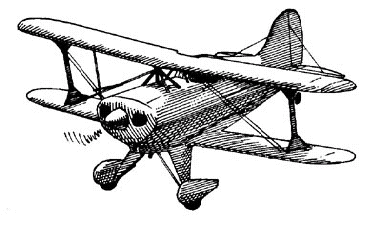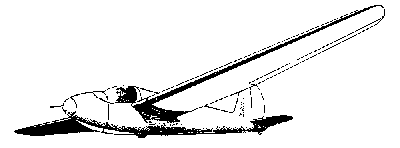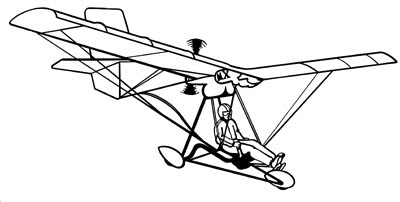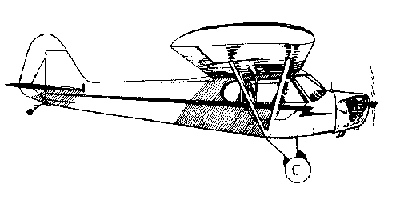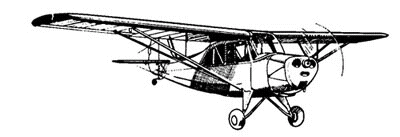Before You Fly: Thoughts on your first flight and the EAA Flight Advisor Program
Introduction
It's sitting out there, all fueled and ready to go. It represents a huge investment in time, emotion and money. More important than that, it represents a dream. A dream that you could build, restore or own an aircraft that represents exactly what you think an airplane should be.
It's sitting there all ready to go. But are you?
You spent many sleepless nights working out the details, making certain everything was right. Undoubtedly you remade or refinished many parts more than once to ensure that first flight and every one after that would be uneventful and thoroughly enjoyable.
You've worked toward perfection on every single part of the aircraft. Now it is time to apply that same thought pattern to perfecting our flying skills.
Unless you are highly unusual, in all likelihood, flying has taken a back seat to your building or restoration activities. Or, if you purchased the aircraft completed, maybe you haven't given nearly as much consideration to improving your flying skills as you have in finding faults in the prospective aircraft purchase.
Don't think you are unusual. The tendency to think of the hardware first and the actual flying second is very common.
Statistics show that 20% of all homebuilt accidents happen during the first two flights and are usually caused by pilot error. Those pilot errors are almost always the result of a pilot flying an aircraft for which he or she wasn't qualified or with which he wasn't familiar.
The same problem exists during the first flight of any unfamiliar aircraft, whether it is a homebuilt, vintage or ultralight. The first flight in an airplane might as well be a test flight because, for that pilot, it is a test flight.
The EAA Flight Advisor Program was developed to provide assistance for pilots who are about to fly any aircraft for the first time. It was developed to tap into the vast pool of experienced pilots in the EAA membership and make them available to help pilots facing a first flight. You may have little experience in your aircraft, but there are plenty of others out there who know your airplane type well. The goal of the program is to have an experienced pilot available as a Flight Advisor to coach you before making those first few critical flights.
Before you fly, call the EAA at (920) 426-6864 and find out who your local Flight Advisor is. Let a fellow EAA'er lend you some of his or her experience and help in making the first flight experience a pleasant one.
Also, if you aren't a member of the EAA or don't belong to a Chapter, give serious consideration to joining. There are many EAA programs and activities - like the Flight Advisors - that will make your flying more fun and safer. There are a lot of EAA'ers out there ready to help. Join in the fun.
The Flight Advisor Concept
The Flight Advisor concept is based on one premise: An experienced EAA member is paired with a pilot inexperienced in a given aircraft so the two of them can evaluate the pilot's skills against what that airplane will require to be flown safely. It is no more complicated than that.
EAA Flight Advisors, are located throughout the country and the list is growing on a daily basis. They are the same type of person who has formed the backbone of the EAA for more than four decades...dedicated volunteers.
The experience pool within the EAA is enormous. In any gathering of sport aviation enthusiasts, there is bound to be a wide range of experience, but there will always be a number who have experience far and above the norm. In many cases, the experience will be narrow but deep: They may have spent their life flying and operating a specific type of aircraft. Or their experience spans dozens of different types and categories: They have flown many antiques, homebuilts or ultralights and are comfortable in them all.
EAA Flight Advisors specialize in what they know best. It may be ultralights, high performance homebuilts, two-place classics, or any of a wide number of possibilities.
From your perspective, the most important fact is that there is a Flight Advisor near you with the experience or resources concerning your particular airplane. He can answer questions about how it flies and what you can expect.
Evaluation Is The Key:
Understanding Yourself And Your Aircraft
The EAA Flight Advisor's primary function is to hold up a mirror so you can clearly examine yourself as a pilot. Then the two of you will examine your aircraft and its characteristics.
The EAA Flight Advisor isn't there to make any judgments. Nor is he there to make any decisions. He won't look at you and tell you you are either a hero or a bum. He won't tell you yes you can fly, or no you can't. That is your responsibility. It's your decision.
What the Flight Advisor will do is take you through a formalized evaluation process that will focus first on your aircraft and the skills it requires to be flown off your airport safely. Then your skills, as a pilot, will be compared to the profile drawn of the aircraft to see if there is a match.
The ultimate goal of the evaluation process is a "go/no-go" decision. You have to decide whether the evaluations say you are suited to fly the airplane or not.
An alternate decision may be that, yes, you could fly that aircraft but only with more training. If that's the case, the Advisor will help guide you in finding the right kind of training.
Evaluating The Aircraft
Not all aircraft are created equal. Even aircraft of a given type change personality from one example to another and, without actually flying the aircraft, it is difficult to tell exactly what yours will fly like.
The Flight Advisor is experienced either in your airplane or aircraft which are similar. He or she also has a broad base knowledge of the type so he or she can make generalities as well as specific statements about how it is likely to fly.
Flight Characteristic Evaluation
The Flight Advisor will use a standardized form that takes the design specifications of your aircraft and uses them to draw an outline of the type's general flight characteristics.
The Flight Advisor will take some basic aerodynamic parameters such as wing loading, power loading and aspect ratio and compare them to the same factors of "normal" general aviation aircraft you have flown. That will paint an accurate picture of how your airplane is likely to compare to aircraft you already know well, so you'll know how your experience matches.
The Advisor will color those parameters with personal understanding of the aircraft to give some of the intangibles the numbers don't necessarily show. You’ll then know whether the airplane is known to have an extremely high roll rate coupled with light control pressures, or whether it will sit there like a rock asking you to work for what you get.
You will also look at your weight and balance and help you determine how that is likely to effect the flight characteristics of your aircraft, as compared to the norm for its type.
Don't Under-Estimate Low and Slow Airplanes
There is a tendency to think light, low-powered aircraft or ultralights don't demand as much piloting skill as the higher performance models. That is very true in some areas, but definitely not in others.
A low-powered aircraft doesn't have the ability to power out of bad situations and a lightly loaded airplane will be much more affected by wind and gusts. Often, this type of aircraft also doesn't have the control response to overcome severe wind or gust factors. It's just as easy to get in trouble in a low and slow bird as one with lots of performance; it just happens at a slower speed.
Not All Airports are Good for All Aircraft
Airports can take a medium demand aircraft and make them into high demand airplanes just because there isn't a good match between the aircraft's characteristics and the airport environment.
A fast aircraft that is fairly easy to fly on a long runway becomes a real handful if it has to be put down on 2,000 feet. A slower airplane, like an old biplane, may be happy as a clam on that much runway. However, that same biplane probably changes runway personality drastically when it goes from grass to pavement, so if the 2,000 feet is pavement, it is still a higher demand aircraft.
If the aircraft is carrying a lot of pounds and not much horsepower, it's not going to be much of a climber, so trees that go unnoticed for most airplanes suddenly get very tall.
Flying any aircraft for the first time is a test of any pilot's skills, but the airport can easily push the pilot out of his personal skill envelope. The Flight Advisor can give input on the aircraft/airport match.
Evaluating Yourself As A Pilot
There are a lot of different aspects of the human animal that have to be evaluated when it comes to climbing into an aircraft for the first time. The prudent pilot will stand back and take a long look at themselves and do some brutally honest self-evaluating.
This is no place to let your ego or inflated self-image get in the way. This is a place for you to sit down with a Flight Advisor and go through the same by-the-numbers type of evaluation you did on your airplane.
Again, remember: The Flight Advisor isn't there to judge you. Or make you feel either bad or good. He is there to help you get a clearer picture of both yourself and the aircraft and, in so doing, make sure you enjoy the first flight.
How's Your Attitude?
This is one the Flight Advisor can only hint at, since it's not his place to tell you, as was said in the movie Top Gun "...your ego is writing checks your body can't cash..." If you have an attitude problem, it may or may not get mentioned depending on how the attitude manifests itself.
Attitude problems come in different flavors, but the most common are, "I built/restored it, so I can fly it," or "...an airplane is an airplane and I can fly most of them..." and "...Nothing is going to go wrong." A variation on these themes is not wanting to go through all the evaluating and planning the Flight Advisor will recommend.
Common sense, aviation safety, the EAA and your family asks you to look closely in the mirror. Do you feel as if you can fly most airplanes without a check-out, but your logbook only has 500 hours of time in it? Have you ever fudged, or outright lied, about what you've actually flown? Are there entries in your logbook that aren't true? No one knows the answer but you.
These are all indications of an attitude that is less than professional and can get you hurt. If you haven't noticed, airplanes aren't impressed by things you say. They only react to what you do.
Does Your Experience Match this Aircraft?
Because different aircraft need different skills, all of your flight experience may not match this aircraft. Your last 10,000 hours in a B-727 won't count for a single thing while trying to drive a Cub through a gusting cross-wind to a landing. A million hours of pipeline patrol in a Super Cub will make you a pro at low level taildragger flying, but with one landing every four of five hours, you won't be ready for a Glasair III on a 2,500 foot strip.
You and your Flight Advisor will work on an evaluation that takes your experience apart and looks for what most closely matches the aircraft to be flown. If it is highly wing loaded (Glasair III), do you have much high wing loading time? If it stalls at 30 mph, has 40 hp and a tailwheel (E-2 Cub), do you have anything in your experience that falls into the low and slow category?
Besides having experience that matches the numbers on this airplane, remember: Only "air work" and landings count. Cross country time doesn't teach you much about an aircraft and all of the action during your first flights is going to happen in the pattern and local area.
Currency - How Much is Enough?
The short answer is "there is never too much currency."
The classic homebuilder/restorer scenario is to hide in the workshop for years, flying only occasionally, if at all. Then, as it comes time to fly the airplane, a hurried rush is made out to the airport and five hours put into a rental C-172.
That is not currency, although in some situations with some pilots, that might actually be plenty. It depends on the pilot's overall experience and how recent it is.
After a period of time, skill becomes an intellectual memory that your brain retains but, as the fog of time sets in, the brain has an increasingly difficult time getting the skill to the hands at the appropriate time. The amount of time it takes to regain that skill is largely dependent on how much experience was stuffed into the brain in the first place and how long that skill has laid dormant.
The evaluation is going to home-in on what you've been doing for the last six and 12 month periods. It's not only a matter of how much flying was done, but in what kind of machines and how many landings were made. Here, too, a match to the subject aircraft is important.
Proficiency - How Good Are You, Really?
Being experienced and current doesn't necessarily mean you are proficient. Proficiency is skill and it is not something which is absolutely tied to experience. In fact, it's quite common to see high time pilots with low skill levels and vice versa.
Proficiency is also one of those things the Flight Advisor can't judge from looking at your logbook. This can only be done by observing how you fly and, since the Flight Advisor will do no flying in his capacity as an Advisor, it might be a good idea to get an unbiased proficiency review from your local flight instructor.
The Flight Advisor has a Pilot Proficiency Checklist that you can give to your CFI. The checklist will not only give the CFI an idea of how the ride might be conducted, but also includes a rating sheet that can be used in assessing your skill level.
Basically, the proficiency ride will consist of you shooting a number of landings with a very quiet, but observant, CFI onboard. Since you are going to be up there by yourself on that first flight of your own aircraft, riding around with a silent instructor shouldn't be a problem.
The results of the proficiency ride will be another data point which you and the Flight Advisor use to evaluate your ability to conduct the test flight safely.
The proficiency ride will also be used to determine whether additional training would be recommended to bring your skill levels up to that which the subject airplane demands.
The Test Pilot Option
Okay, so let's say some tiny voice inside says you aren't up to the job. What do you do?
The Risk Isn't Yours
The first thing you do is to recognize that flying an aircraft is not without risks of its own and flying an airplane when you know your skills aren't adequate is foolhardy.
No pilot is without friends and family and, if there is an accident, they are the ones who suffer the longest and hardest. It's their life, as well as your own, you are risking.
There's No Shame In Saying No
No one is going to brand you a coward if you decide to have someone else fly your aircraft for the first few times while you take more training. If, however, you strap it on and you aren't ready, they'll brand you a fool.
Evaluate a First Flight Pilot - Not Everyone is Right for the Job
When looking for someone to fly your airplane, evaluate them the same way you evaluate yourself. Judge their experience and proficiency the same way and make certain it matches your aircraft. Just because someone is a local airport legend with thousands of hours instructing, doesn't mean he or she is the right one to test hop your airplane.
Besides matching experience and skill, the pilot's attitude has to be right. That means it has to be professional. You and the Flight Advisor will be working out exact plans (actually scripts) as to how the flights will be conducted and the test pilot has to be willing to adhere to those plans. That pilot shouldn't be someone who is just going to ram the throttle forward and see what happens. He has to approach the project in the same careful manner you used in developing your flight plans.
If yours is a kit-built aircraft, chances are the factory has a test pilot who can be hired to do the job for you or recommend someone with specific experience locally. In most cases, this is money well spent because the factory pilots not only know how to fly the airplane, they know exactly how it is supposed to fly. If something is wrong with your aircraft, they can probably tell you how to fix it.
If yours is an ultralight, light plane, rotorcraft or vintage plane, the type clubs may have a listing of check pilots who can work with you.
Time To Fly? Time To Plan!
When it comes to doing first flights of a newly built or restored aircraft, nothing re- lieves load on a pilot as much as complete planning. Every aspect of the flight should be carefully choreographed so everyone knows what to expect and when.
Planning takes the place of crisis management, which is important because the brain doesn't always work well in tense situations.
Develop a Tight, Simple Script
During each phase of the flight, takeoff, climb, pattern work, approach and landing there are certain items which must be remembered, checked and recorded. Unfortunately, the ability to remember all of those items generally disappears because everything fades to insignificance as soon as the nose is up and the airplane is off the ground. The usual reaction is to listen so intently for the engine to miss that not another thing is noticed during the entire flight.
The Flight Advisor has been through this process before and knows what to look for. He also has a pre-prepared, easily read script which may help you in conducting the flights. This will allow you to concentrate on flying and less on remembering.
Your Aircraft as a Simulator
There is no substitute for acting out the flight on the ground and in the cockpit. With the aircraft parked on the ramp, you and the Flight Advisor can go through each step of the flight, complete with the actual movements you'll be doing in the air.
The Flight Advisor will show how you and a friend can run cockpit familiarization drills, maybe with you blindfolded. This way you'll be able to find every instrument without having to think about it. During the cockpit familiarization phase, you will be looking over and around the nose and developing a set of ground references so you'll remember how the runway is supposed to look in the windshield just prior to touchdown.
With the Flight Advisor or a friend out of sight but talking to you via radio, the two of you can fly many simulated takeoffs and landings. The more you play act, the more instinctive your actions will be.
The Flight Advisor as Your Radio Angel
The Flight Advisor may be on the ground, radio and script in hand and will function as your co-pilot for the duration of the flight. If you elect this option, it will be as if the Advisor is in the cockpit with you during each phase of the flight.
Periodically, you’ll be asked to read him certain instruments that will be logged in so you'll come back with a complete set of test data to analyze.
The Advisor will also be there to work with you in case there is some sort of system problem and you need an additional head to help with planning.
Don't Forget Emergency Training
While you're doing simulator training, don't forget emergency training. Hopefully, nothing will go wrong, but that's not always the case. Accident investigations of some of the early flight accidents have shown many of the pilot error incidents were precipitated by a minor system failure of some sort. But the pilot wasn't prepared and couldn't deal with the emergency and fly the airplane at the same time.
Without warning, right in the middle of conducting some sort of simulator drill on the radio, the Flight Advisor will say, "...engine failure!.." or "... jammed elevator ...!" It will be up to you to visualize where you were in the pattern when the fictional incident occurs and figure out what to do about it. Run through all the steps in the cockpit until it becomes second nature to you.
Flight Training
If you decide not to fly the aircraft or decide you can fly it with more training, it is time to start looking for the right flight instructor and the right airplane.
Underline the word "right" in the above because, as with everything else in the first-flight arena, the training must match the aircraft and airport at hand.
The Right Instructor
The right instructor is one who is familiar with the airplane to be flown and can couch his instruction in such a way it prepares the pilot specifically for that machine. Such instructors don't exist on every airport.
The EAA is rapidly expanding its Flight Instructor Directory seeking those who feel qualified to train pilots for specific types of aircraft, i.e. high performance homebuilts, vintage biplanes, etc., which will greatly simplify your search. If, however, there is no one local listed and you don't want to travel, it is important you evaluate your flight instructor candidates carefully.
The Flight Advisor is prepared to help you conduct a formalized search for the right instructor. He knows the aircraft's flight characteristics and knows what kind of background and instructional approach must be used by the instructor.
Seek An Equivalent Aircraft
As a normal rule you won't be able to get flight training in the exact type of aircraft to be flown. About the best you can do is find a trainer that mimics as many of the aircraft's known flight characteristics as possible.
It is possible it will require two or more trainers to give a range of characteristics likely to be encountered. For speed, Bonanzas with the flaps up, might be used. A Yankee AA-1 would give training in quick, light controls and high sink rate.
Here too, Flight Advisors can point you in the right direction. They know what the aircraft needs and knows which other aircraft approximate its handling characteristics.
Match the Airport
Since the airport can have an effect on the demand the airplane will place on you, it is best to get your training on the same airport where you'll be flying the aircraft. If that isn't possible, make certain the instructor knows the airport's limitations, if any, and modifies his training accordingly. He can easily train you for narrow, short runways just by restricting what you can use on the existing runway.
If the approach is obstructed, he can simulate that type of problem as well.
Lean On Your Flight Advisor
In case you haven't figured it out, the Flight Advisor is there to be an answer man/woman, trainer, confidante and mentor. The Advisor will function as an extension of your own experience by lending you all of his/hers.
There is no reason to go through this process alone or with a bunch of friends hanging around helping you guess. Call the EAA Flight Advisor and put experience and planning on your side. You will be glad you did.
Fly safely.
